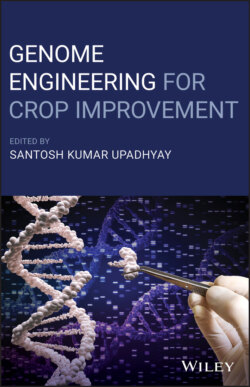Читать книгу Genome Engineering for Crop Improvement - Группа авторов - Страница 56
3.4.1.9 Application of CRISPR/Cas9 for Soybean Quality Improvement
ОглавлениеThe genetic transformation methods in plants have made tremendous progress especially in soybean breeding programs, to produce novel, and genetically variable, plant material. These transformation techniques have been utilized previously to study the functional aspects of soybean (Stewart et al. 1996). These transgenic plants represented a priceless tool for molecular, genetic, biochemical and physiological studies by gene overexpression or silencing, transposon‐based mutagenesis, protein sub‐cellular localization and/or promoter characterization. However, there are some disadvantages to this traditional method. The introduced genes may cause non‐targeted mutagenesis ultimately interrupting the endogenous or exogenous genes which may have negative results. The RNAi technique possesses the ability to silence a whole gene family hough, the silencing of only targeted gene is required. The genome modifications of soybean are complex due to the fact that genes are highly duplicated in nature. Thus, precise, efficient and straightforward methods for researching gene functions and genome engineering are required. Recently, CRISPR/Cas9 has emerged as a robust and effective technology for editing each member of a gene family without influencing other genes or simultaneously editing multiple genes of interest, thereby overcoming the shortcomings of the traditional plant‐breeding methods.
Genome editing has emerged as a better choice for molecular breeding than transgenesis and it is well accepted by society. Cai et al. (Cai et al. 2015) first successfully realized CRISPR/Cas9 mediated genome editing in soybean using a single sgRNA for a trans gene (bar) and six sgRNAs that targeted different sites of two endogenous soybean genes (GmFEI2 and GmSHR) and understood deficiency of the sgRNAs in a hairy root system. The targeted mutagenesis of two genomic sites in soybean chromosome 4 (DD20 and DD43) caused frame shift mutation (Li et al. 2015). The targeted gene integrations through HDR were detected by border‐specific polymerase chain reaction analysis at callus stage. Soybean GmU6–16‐1 promoter was found to be more efficient in simultaneous editing of multiple homoeoallelesrelativetotheArabidopsisAtU6‐26 promoter (Du et al. 2016). The role of a dominant nodulation restriction gene in soybean, Rj4, that inhibits nodulation by many strains of Bradyrhizobium elkanii was shown through both complementation and CRISPR/Cas9‐mediated gene knockout experiments (Tang et al. 2016). CRISPR was used to disrupt the pathogen virulence gene (Avr4/6) in Phytophtho rasojae (Fang and Tyler 2016). Homologous genes placement of Avr4/6 by a marker gene (NPT II) stimulated by the CRISPR/Cas9 system emphasized the contribution made by the virulence gene in recognition of the pathogen by plants containing the soybean R gene loci, Rps4 and Rps6. CRISPR knockout of the soybean flowering time gene, GmFT2, was stably heritable in the subsequent T2 generation, with homozygous GmFT2a mutant inhibiting late flowering under both long‐day and short‐day conditions (Cai et al. 2018). The first soybean product, produced by genome editing, was announced in early 2019 and will be available on the market soon. By using the transcription activator‐like effector nuclease (TALEN) technique, a new high‐oleic‐acid soybean cultivar has been made without introducing foreign DNA into the soybean genome (Calyxt Inc2019). Vegetable oil, produced with this new soybean cultivar, contains 80% oleic acid and has 20% less saturated fat, which makes the oil healthier for human consumption, and the shelf life of the oil is also extended (Splitter 2019). It is expected that the high‐oleic‐acid soybean oil will be the first gene‐edited plant product to be commercialized (Calyxt Inc 2019; Splitter 2019). Most of the genome editing studies were focused on disease resistance and photoperiod sensitivity in soybean, however, the nutrition aspects are less studied which need further attention. So far, the genomics of soybean nutrition is a concern and several studies have been undertaken to highlight the genomic architecture soybean nutrition.
To improve the oxidative stability and quality of soybean oil, breeding programs have mainly focused on reducing the saturated fatty acid and linolenic acid contents and increasing oleic acid in the oil. Hence, delta‐12 fatty‐acid desaturase 2 (FAD2), which converts oleic acid (18 : 1) to linolenic acid (18 : 2), becomes the target for modification via molecular breeding. There are two FAD2 loci, FAD2–1A (Glyma10g42470) and FAD2–1B (Glyma20g24530), in the soybean genome. To develop high‐oleic‐acid lines (> 80% of total oil content vs. an average of 20–50% among existing soybean cultivars), efforts were made to combine a recessive mutant allele at the FAD2–1A locus (Glyma10g42470) and a recessive mutant allele at the FAD2–1B locus (Glyma20g24530) using molecular marker assays (Pham et al. 2011). In a later study, a non‐synonymous SNP on FAD2–1A (S117N) from 17D, an EMS mutant of Wm82, and another one on FAD2–1B (P137R), a mutant allele from PI 283327, were identified to be highly associated with the high‐oleic‐acid phenotype (Kulkarni et al. 2018). Similarly, an EMS mutant, PE1690, derived from the cultivar, Pungsannamul, was found to be low in linolenic acid. The phenotype was the result of a single‐base mutation (W128*) in the GmFAD3A gene on the locus Glyma14g37350, which rendered the desaturase enzyme non‐functional (Chahal and Gosal 2002). A derived cleaved amplified polymorphic sequence (dCAPs) assay specific for this artificial polymorphism was thus developed for future breeding activities (Kim et al. 2015). These studies have provided insights and, based on these observations, future studies can be designed utilizing modern technologies to improve soybean quality to fulfill the consumer requirements.
